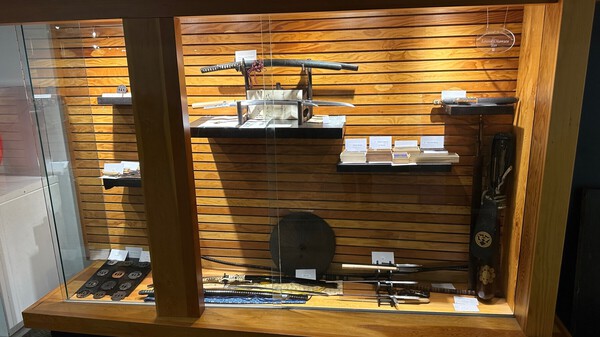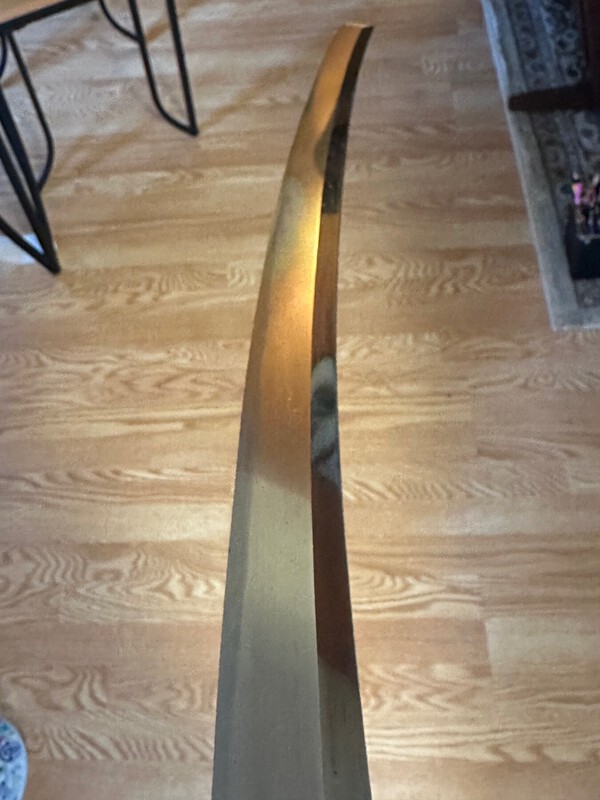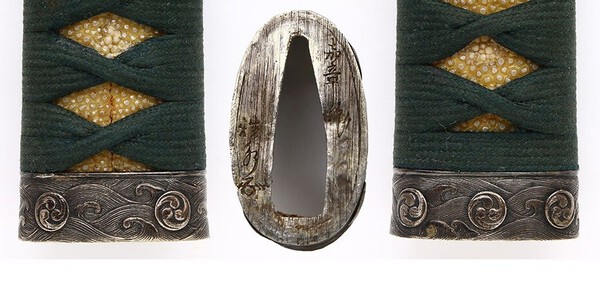-
Posts
391 -
Joined
-
Last visited
-
Days Won
2
Everything posted by ckaiserca
-
Member of NBTHK AB and a member of the Toronto Japanese Canadian Cultural Centre Token Kai.
-
I would strongly suggest that he display the koshirae with the tsunagi and keep the blade in its shirasaya. It should be fine to keep it displayed like that indefinitely.
-
Very hard to tell anything from these photos. I can't make out any trace of a hamon and it looks like there is either rust or some other damage to to blade’s edge. Without better pictures, I would pass on this one.
-

delayed export permits
ckaiserca replied to lonely panet's topic in General Nihonto Related Discussion
Torokusho are supposed to be kept with the sword at all times. I doubt any dealer is just sending in a random Torokusho for an export permit. They take record keeping very seriously in Japan -
My wife and I will be visiting San Francisco from July 14 to 18. Are there any Nihonto related “must sees” that I should be aware of? Thanks,
-

How were Gunto and the like looked after in the field?
ckaiserca replied to matei's topic in Military Swords of Japan
For those who may be interested, I did a quick machine translation of the article: The year of Showa 12 (1937) was a great turning point for Hikosaburo Kurihara. From May, I traveled for a new Japanese sword full-fresh business trip exhibition, and soon after returning home, I went to Manchuria again. It is to see the rot of Showa swords and plan and investigate the establishment of a Japanese sword training school on site. However, the training school was not born in Manchuria. In the wake of the Sanko Bridge incident, there was an all-out war with China. Because I went in, dispatch of the Imperial Army Consolation Local Service Group (Local Service Group for Military Sword Repair) here has been decided. The plan assumes that the battle period will be one year, and a group of 5 to 7 people will be formed into 20 groups, a total of 100 people, and a total of 3,000 people will be dispatched, and emergency repairs such as blade care, polishing, and handle winding will be performed once per person per day, and a total of 30,000 swings will be repaired. I'm doing. Fruit. In some cases, the period and scale were more than this. Hikosaburo contracted amoeba dysentery at the Soman border in the summer of Showa 10, and since then he has often developed symptoms and has reached a critical condition. This disease is characterized by severe diarrhea, and the physical exhaustion is significant, causing complications. It seems that there was no effective treatment at that time. It is said that he was in a state of command from the hospital bed until just before he left as the leader of the first squad. It seems that he was also prepared, and he called himself the book of death "Sujuzoei" published in the middle of the business. See the portrait of that time. And there is exactly the atmosphere of "the demon of the country" in the air. After the election of the House of Representatives in February 1919, Hikosaburo left politics and devoted himself to the reconstruction of the Japanese sword. And with this military sword repair business, we clearly identified the role of Japanese swords and swordsmiths, it will make "Forged Sword Hokoku" flourishing. -
Welcome to the NMB. It looks like you have already accumulated an impressive collection.
-

Thanks for the acceptance. Newish Collector.
ckaiserca replied to TnShinobi2024's topic in General Nihonto Related Discussion
Welcome to the NMB. This is a fantastic place for learning about Nihonto. You will be happy you landed here. -

Possible nihonto identification
ckaiserca replied to Muaythaimals's topic in General Nihonto Related Discussion
Typing on an iPhone isn’t ideal. -
Hi Roman, There are several member on this board from Canada. Where in Canada are you located? Toronto has a very active Token Kai located at the Japanese Canadian Cultural Centre. There is a meeting next this coming weekend, Saturday, June 8 at 12:30 pm. I won’t be able to attend, but visitors are more than welcome.
-

Possible nihonto identification
ckaiserca replied to Muaythaimals's topic in General Nihonto Related Discussion
Choji oil is really just mineral oil with a bit of clove scent added to it. Tsubaki oil is camilla oil. A good quality mineral oil such as what you can buy at just about any pharmacy will work too. There is nothing that you can do yourself about the rust. That is something that this group strongly advises is done by a fully qualified sword polisher. A sword care kit will have uchiko powder in it. This really wont do anything to remove active rust, and can damage the sword further. It is strongly recommended that its use be avoided. -

Recommendations for koshirae
ckaiserca replied to Avidmark's topic in General Nihonto Related Discussion
This could save a couple thousand dollars or more depending upon the quality of the tosogu you choose. -

Possible nihonto identification
ckaiserca replied to Muaythaimals's topic in General Nihonto Related Discussion
Real Nihonto, but it has active red rust. You need to make sure you apply a good oil to help stop further damage. Do not do anything else to try and clean the blade. This is a project for professionals only. I use 100% Tsubaki oil for my swords. This is easily found on Amazon. Note that some Tsubaki oil offers come with something called a “Rust Eraser.” Under no circumstances should you use this on a Japanese sword! -
If anyone in Toronto or from around the GTA is interested, the Toronto Token Kai will have a table and display at the Japanese Canadian Cultural Centre on Saturday and Sunday from 10:00 am until 5:00 pm. This is part of Doors Open Toronto. I will be manning the information table with other members of the Token Kai. 6 Sakura Way Toronto ON M3C 1Z5 Canada
-
- 4
-

-
100% Tsubaki Oil is a good choice and is easily acquired on Amazon. Note that some of the listings for Tsubaki Oil on Amazon come with something called a "rust eraser." Under no circumstances should you use this on a sword blade.
-

Any info? Apparently ww2 era.
ckaiserca replied to dez's topic in General Nihonto Related Discussion
It is difficult to tell from the photos, but my mind goes directly to "not Japanese." I see two problems: the wrapping on the Tsuka is all laid in the same direction, and proper Japanese wrapping always alternates. The fact that the sword has two meguki (pegs that hold the Tsuka) is off as most Japanese swords would have only one. A sword can have two, but it is rare, especially in a wakizashi. -

How to remove green corrosion?
ckaiserca replied to Yumso's topic in General Nihonto Related Discussion
The motif of the Kashira is interesting. It appears to be an Asian man and a European man. The European man looks like he has a clown's nose. -
The geometry of this blade is terrible. The rippled appearance is all wrong. The shinogi-ji should be a precise line between the shinogi and the hira-ji.
-
Jacob, The photos that you have provided show all of the hallmarks of a bad Chinese fake: The tsukaito on the hilt does not alternate as it would on a real Japanese item. The Seppa that is shown covers the kogiana of the Tsuba making it useless (Tachi do not have kogai or kozuka anyway) The Kissaki of the blade is the wrong shape The habaki would not have a serial number on it The hamon appears to be acid etched Overall, the craftmanship is poor. The kashira that you show is far too round. A tsuka would not be that shape. The "Mei" is meaningless (and when you post pictures of a nakago, you should post them with the point of the blade upwards. your photos are upside down. If you know anything about Japanese swords, you would know this)
-
You might get more help if you post this topic in the "Military Swords of Japan" section. Perhaps one of the moderators could move it there...
-

Possible to Read Mei on This Fuchi?
ckaiserca replied to ckaiserca's topic in Translation Assistance
Thank you! -






